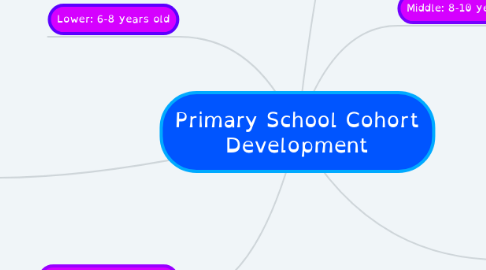
1. Upper: 10-12 years old
2. Lower: 6-8 years old
3. Physical Development
3.1. Puberty
3.1.1. Girls: Begins at 8-13 years old
3.1.1.1. Oestrogen develops
3.1.1.1.1. Girls become more emotional and fragile in this pre-teen age
3.1.1.2. At 9-12 years of age, menstruation begins to occur
3.2. Growth: Height and growth spurts
3.2.1. Girls: A growth spurt occurs around 9-10 years of age
3.2.1.1. Growth spurts can cause pain or discomfort and therefore serve as a distraction to learning
3.2.2. Boys: A growth spurt occurs around 11-12 years of age
3.2.2.1. Boys are now at a volatile pre-teen age, so the growth spurt can, much like in girls, serve as a distraction to learning.
3.3. Body shape
3.3.1. Weight
3.3.1.1. Tends to fluctuate throughout primary school ranging from 'puppy fat' through to 'hormone weight'
3.3.2. Muscle mass
3.3.2.1. Muscles begin to develop properly through primary school as the muscle group begin to be utilised
3.3.2.1.1. Physical education curriculum:
3.3.2.1.2. Health curriculum:
3.3.2.2. Muscles also naturally develop as the child grows
3.3.3. Visible shape
3.3.3.1. Curves
3.3.3.1.1. Extra curves such as breast development may begin in females, potentially causing embarrassment which can be a distraction to learning.
3.3.3.2. Shoulders broaden
3.3.3.2.1. In males, shoulders tend to begin to broaden, making the body appear wider. For some primary-aged boys, this may not be the case so the boys who's shoulders do broaden may be ostracised
3.4. Brain Development
3.4.1. Motor skills
3.4.1.1. Fine motor skills
3.4.1.1.1. Fine motor skills are small bodily movements that are usually quite fiddly
3.4.1.2. Gross motor skills
3.4.1.2.1. Gross motor skills are larger, full body movements
3.4.2. Personality
3.4.2.1. Controlled by the development of the pre-frontal cortex
3.4.3. Health
3.4.3.1. Health can be stunted by a number of medical or mental conditions.
3.4.3.1.1. Common illnesses in children can affect their learning in different ways
3.5. Language development
3.5.1. Age 0-2 years old
3.5.1.1. Child is developing the fundamentals
3.5.1.1.1. Speaking: Mumbled sounds and small words such as 'mum' and 'please' are developed
3.5.1.1.2. Listening: Learning to respond to audio stimuli
3.5.1.1.3. Writing: no written skills are developed yet
3.5.2. Age 4-5 years old
3.5.2.1. Child begins to understand meaning of others' conversations. They are able to understand and respond to conversation. They are beginning to learn how to write simple words and their name.
3.5.3. Age 5-7 years old
3.5.3.1. Multistep instructions are introduced and carried out. Ideas become more detailed
3.5.3.1.1. Physical education curriculum:
3.5.3.1.2. English Curriculum
3.5.4. Age 7-8 years old
3.5.4.1. Listening skills are more developed, so the child understands what is being asked of them and usually they oblige. Their attention span develops, so that they are able to listen to instructions more explicitly.
3.5.4.1.1. English curriculum:
3.5.4.1.2. Physical education curriculum: transition period: Fundamental movement skills to game skills
3.5.5. Age 8+
3.5.5.1. Vocabulary is improved continuously from this point and listening development is even greater.
3.5.5.1.1. English curriculum: Speaking and listening
3.5.5.1.2. Physical education curriculum: Sports such as soccer and AFL introduced with rules
4. Middle: 8-10 years old
5. Cognitive Development
5.1. Vygotsky
5.1.1. Cognitive development is driven by social interaction and experience
5.1.1.1. This means that group activities and social interactions are fundamental for children's cognitive development.
5.1.1.1.1. English curriculum:
5.1.1.1.2. For example:
5.1.2. Cognitive development varies and differs depending on culture and time
5.1.2.1. Cognitive development varies through ethnicity and culture. This is due to beliefs and allowances within that culture. For example: a student with English as a second language will be more likely to process reading and writing subjects much slower than a student who has English as their first language.
5.1.2.1.1. English curriculum:
5.1.2.1.2. For example:
5.2. Piaget
5.2.1. Cognitive development is formed and driven by the way children adapt to new experiences.
5.2.1.1. EXPLAIN
5.2.1.1.1. CURRICULUM
5.2.1.1.2. For example:
5.2.2. Cognitive development is universally similar for all children.
5.2.2.1. All children have the same building blocks and the opportunity to utilise them. Children of the same age should cognitively develop at relatively the same pace.
5.2.2.1.1. Physical education curriculum:
6. Social Emotional Development
6.1. Responsible Decision Making: Making ethical, constructive choices about personal and social behaviour
6.1.1. Examples include evaluation, reflection and decision making process
6.1.1.1. Science Curriculum
6.1.1.2. English Curriculum:
6.2. Relationship Skills: Forming positive relationships, working in teams, dealing with conflict.
6.2.1. Examples include group work, ice breakers, storytelling, news and developing leadership in the classroom environment
6.2.1.1. English curriculum:
6.3. Self-Management: Managing emotions to achieve goals
6.3.1. Not being discouraged from tasks or subjects despite lack of understanding. Teacher can create a safe classroom climate to assist in learning and establishing prior knowledge.
6.3.1.1. Mathematic curriculum:
6.3.1.2. Health Curriculum:
